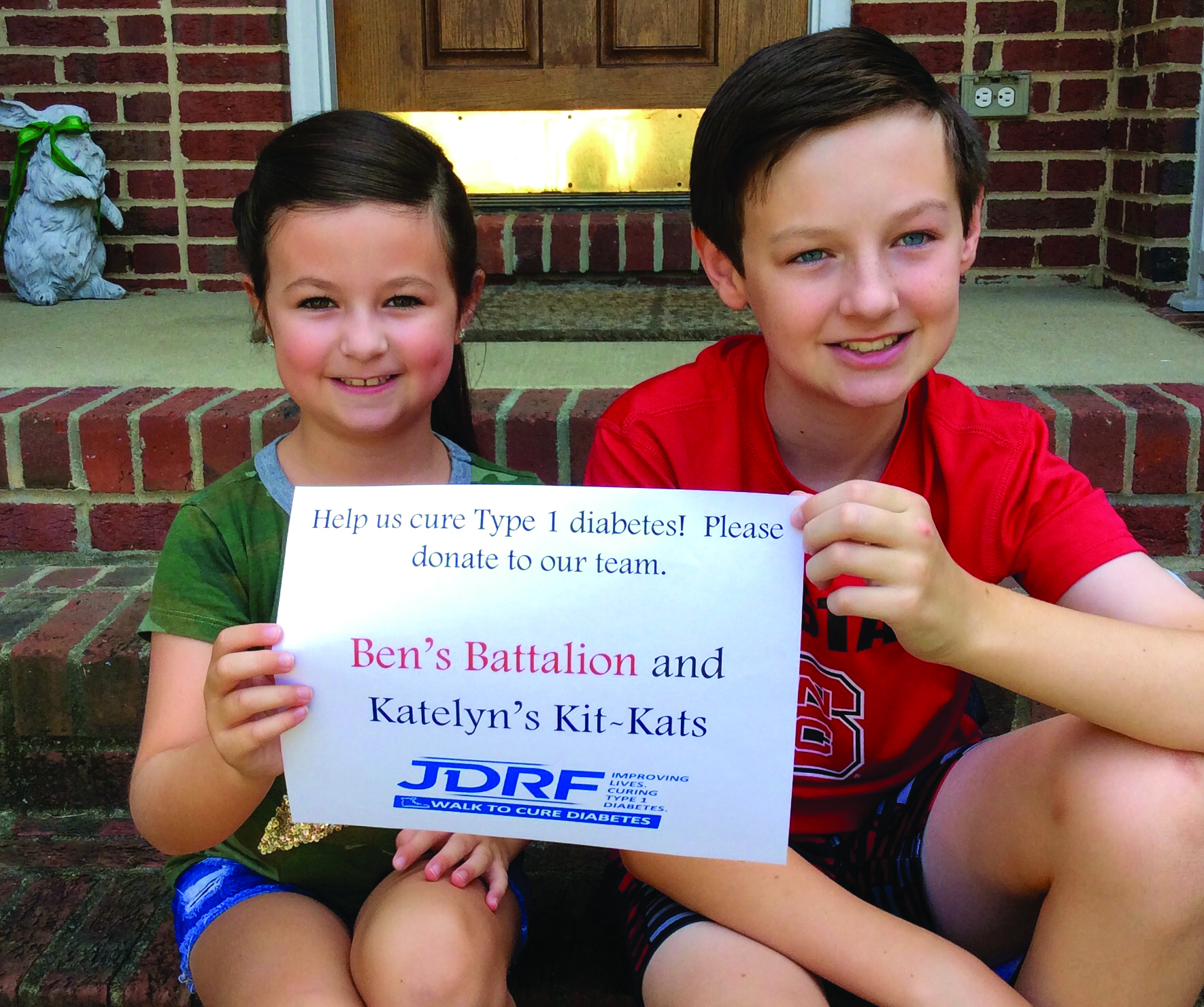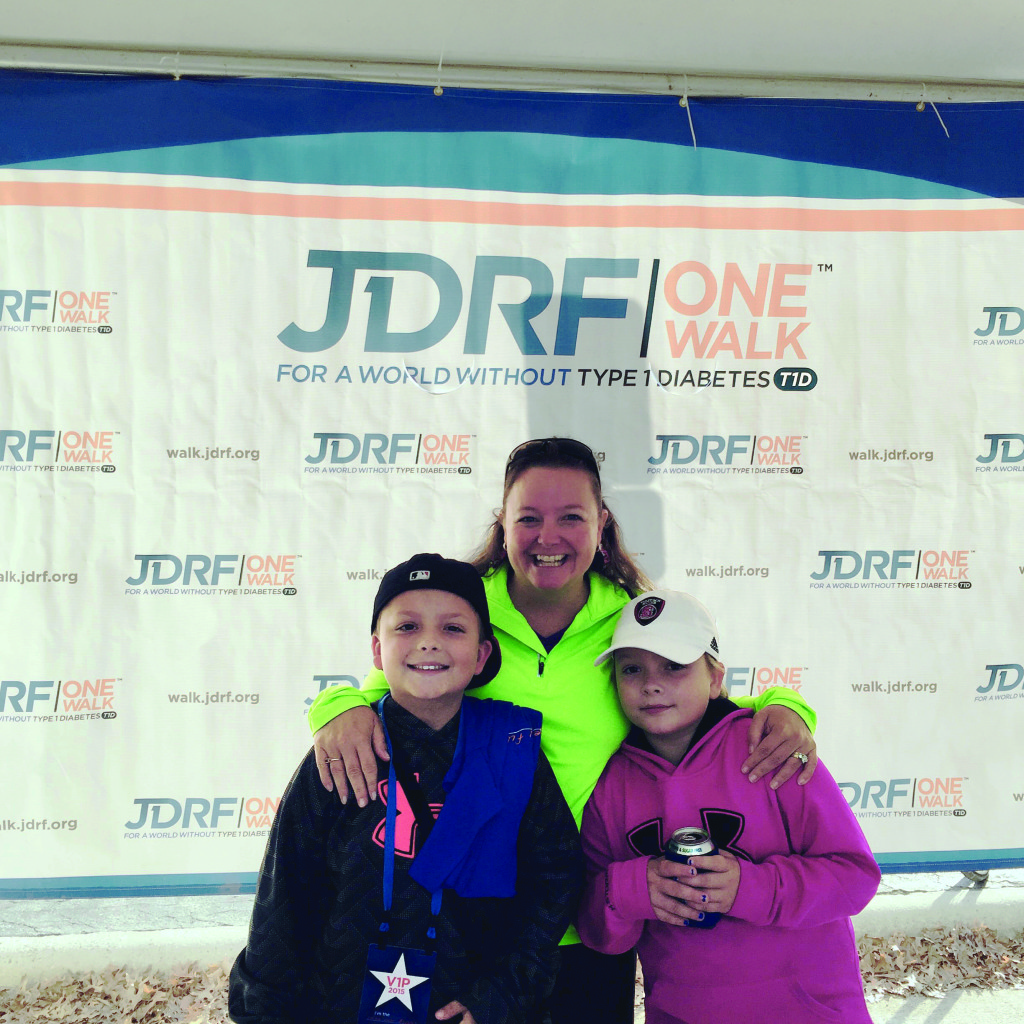Innocence Cut Short
Childhood, a time of reckless abandon. A time where worries are few and excitement and adventure are around every corner. For a brief snippet of our lives, we can live without having to overthink or overanalyze, we can just be. But what would happen, if in an instant, the worries became many and the future was uncertain. What if every day was a constant process of analyzing and thinking and planning. For children with Type 1 Diabetes, their reality changes in a heartbeat. With the prick of a finger and a drop of blood, their lives and the lives of their families are turned upside down.
What is Type 1 Diabetes?
According to the Juvenile Diabetes Research Foundation, Type 1 Diabetes is an autoimmune disease in which a person’s pancreas stops producing insulin, a hormone that enables people to get energy from food. Diabetes occurs when the body’s immune system attacks and destroys the insulin-producing cells in the pancreas. The causes of Type 1 are not entirely understood, however scientists believe that both genetic factors and environmental triggers are involved. Unlike other types of diabetes, Type 1 cannot be prevented, reversed or cured. Type 1 Diabetes, or T1D, can strike at any time, at any age and does not discriminate across racial, gender or socio-economic lines.
Statistics
The number of cases of T1D, specifically in children, are eye-catching. According to the Centers for Disease Control (CDC), in 2015, 23.1 Million people, or 7.2 percent of the population, are believed to have diabetes. Of those, 5.1 percent have Type 1, including 132,000 children younger than age 18 and 193,000 younger than 20. Unfortunately, with no known method of prevention or cure, that number is expected to rise each year.
What Does T1D Look Like?
So, what does T1D look like? For four Apex families, it looks like their sons and daughter. It looks like a healthy child one day and the next it is tubes and needles and calculations. While it is true that each child, each case, and each family is different, they all share one daily goal: Get through today and let my child be as healthy as possible.
Community
In Apex, there is a group of families who have known each other and socialized over the years. Their children are friends and schoolmates. They have several things in common, children of the same age, careers, and social circles. But one thing they never thought they would have in common is the fact that each of them has one or more children suffering from Type 1 Diabetes. For Kathy, Kim, Krista and Tara, the bond of being mothers of children with T1D is one they are grateful for and despise at the same time.
Cecil | Age 13
When a child has a condition or an illness, as a parent you do as much research as you can to become educated and knowledgeable. But what happens when you don’t know what you are supposed to be researching? When Cecil Wilder was just 6 years old, his parents, Tara and Randy, tried everything in their power to try and help him with what they thought was an issue with increased accidents at night. “I did all my research on bedwetting. We bought alarms, we cut off food and drinks at 6pm and nothing worked.” After more than two weeks of getting up four times per night and doing everything their pediatrician recommended, a urine test was done and ketones were found. “Our pediatrician wanted us to go to the hospital immediately
for a blood test. Once the blood test results came back, they wanted us to go to Wake Med in Raleigh immediately,” Tara said. At this point they had not
been told the outcome of the blood tests. When she asked, the pediatrician told them “your son has diabetes.”
It was at that moment that Tara and her husband had to jump into action. It was then a matter of planning. Planning for their younger daughter Anna Kaye, planning for their son and planning for themselves. In the midst of all of the chaos and questions, Tara still found a reason to be thankful. “My baby, my six-year-old baby, walked into Wake Med on his own two feet. We got dealt a really crappy card called diabetes, but within 48 hours my baby walked out of Wake Med, carrying the diabetes card, but it wasn’t cancer, it wasn’t leukemia, it wasn’t a myriad of other horrific things that other parents have to deal with.” But even with the positive outlook that Tara and her family had, there is still the guilt. The desire, but inability to fix things for your child. “I think all diabetic parents feel the same guilt.
I should have seen this, I should have known, why didn’t I know? I should have, I could have.”
For most parents, once your child reaches a certain age, you can once again sleep through the night. The stage of walking through your days with eyes half open are a distant memory. For diabetic parents, this is a never-ending phase of their life. Their nights consist of waking every 2-3 hours to make sure their child is not slipping into a coma. The early hours in the morning that are reserved for peaceful rest and vivid dreams are consumed with numbers and calculations. There is no “this phase will pass” for diabetic parents. Also like having an infant, leaving the house requires planning and packing. For Cecil, this means gathering his items in what he calls “the gas can.” His “gas can” consists of a glucometer, granola bar, icing (for when immediate sugar is needed) and a Glucagon (used in emergency situations only). He has his kit with him at all times. He has it at school, during sports, at home and visits with friends. It is his lifeline should something go wrong.
As a parent, you want your child to reach for the sky and do and become anything they want in life. After his initial diagnosis, Tara said she was disappointed for Cecil. “I was disappointed knowing that he’s not necessarily limited in what he can do after this diagnosis, but he has more hurdles to get to be what he wants to be and do what he wants to do.” But Cecil hasn’t allowed these hurdles to slow him down. He has faced them head-on and conquered them all. He plays soccer and swims and is your typical teenage boy. Cecil is a thoughtful, brave and courageous boy who has taken this hand he has been given and dealt with it the best way he knows how. “If there was ever a kid that would deal well with this, he is it,” Tara said.
Jack | Age 11
The one unique symptom of Juvenile Diabetes, particularly Type 1 is that there is not a unique symptom. Often times signs that may scream T1D can also scream other, much less severe, illnesses. That’s why when Jack’s preschool teacher told his mom, Kathy Skaarup, that he was using the bathroom more than normal, her first thought was not diabetes. “I was kind of ignoring the signs because I just didn’t know about Type 1. He was going to the bathroom a lot, but I just figured he was drinking a lot. Then when the preschool teacher told me he was going three or four times in a three-hour period I knew something was wrong,” Kathy recalls. Type 1 Diabetes wasn’t even a thought until tests showed Jack’s blood sugar to be 445. At that moment time stood still. Like most patients,
as soon as the diagnosis of Type 1 Diabetes was given, Kathy, her husband Patrick and Jack were sent directly to the hospital where they would spend the next 3 days. For the first day and night, Jack was in the Pediatric Intensive Care Unit in order to get his sugar levels stable. During this time, Kathy and Patrick were being taught everything they never thought they would need to know about Type 1 Diabetes.
As a family, they went through multiple classes to learn about diabetes, how to count carbohydrates and how to adjust the insulin rates. Kathy says that these classes were “so beneficial and we learned so much.” Then they were sent home, and reality hit. “It was scary going home that first night, I was a wreck,” she recalled. Since Jack was only five years old at the time of his diagnosis, his understanding of what was going on was minimal. Because of the nature of T1D, it is important for parents to keep a constant check on their children, especially the youngest ones. “Our first night at home was bad. Jack didn’t understand and was very combative when we tried to give him juice because his sugar was low,” she said.
Six years have gone by since that first terrifying night at home. Jack is now an active, sweet and extremely polite eleven-year-old boy who loves soccer. He has matured beyond his years and has become more independent than anyone thought possible at this point. Thanks to a device called a Continuous Glucose Monitor (CGM), Jack is able to be just beyond Kathy’s reach, but still close enough to keep an eye on. Kathy can keep track of Jack’s sugar levels even when he is away from her. An app on Kathy’s phone links to the CGM and can alert her when his numbers get above or below a certain range. This helps take away some of the stress of not knowing how he is when she is not with him, not to mention limiting the number of late night finger pricks. Kathy said that for them the CGM has “been a life changer! I couldn’t imagine having to go back to before we had it.”
Before the days of CGM, playdates and sleepovers were not something Kathy and her husband were able to allow Jack to do. There is a fear, particularly in the middle of the night, that blood sugar will drop and they won’t be aware. Other parents may be uncomfortable having a child with T1D over because of fear of seizures or episodes of fainting. For a parent, it is heartbreaking to have to withhold this special part of growing up from your child. The fact that Jack was so young at the time of diagnosis means he has very little memory of life without T1D. Although this may seem like a blessing, it doesn’t make it any easier on the parents. “He has handled it amazing! Better than I have,” Kathy said. As a parent, we want to fix things for our children and take the hurt away, but the truth is, for parents with a child that has T1D, the struggle is constant with no end in sight.
Ben | Age 14, and Katelyn | Age 8
Having a child with Type 1 Diabetes is devastating. Having two children, diagnosed only a few years apart, is incomprehensible. Ben and Katelyn Harmon are the bookends of three children, Ben the oldest Katelyn the youngest. They have a brother, Grayson, who is the middle child, and the only one without T1D.
Ben was diagnosed two days after his eleventh birthday and ten days before Christmas. His diagnosis came, like most, as a complete surprise. After contracting an upper respiratory infection that had an accompanying fever, Kim and Tony Harmon decided a trip to the urgent care would be beneficial. “It was one of those things that your kid gets sick and you don’t think much about it,” Kim recalls. A urine test conducted at the urgent care showed ketones and a finger prick blood test showed his sugar was over 400. Even at that level, it didn’t occur to anyone that he had Type 1 Diabetes. Kim said that “blood sugar is elevated when you are sick, so we were told to bring him home and watch him for a few days. We did, but something just didn’t sit well with me.” After a trip to their pediatrician he was sent to the hospital. But Ben’s hospital journey was a bit different than others. Kim said that once they were admitted, “They started giving him insulin and his numbers dropped really low. We were there for a longer time because they couldn’t figure out how much insulin to give him.” For Kim and Tony, it was important that their son get the treatment he needed, but still get to enjoy the holidays with his family. Holding on to that small bit of stability and normalcy during a time of chaos is important not only for the patient, but for the family surrounding them.
The oldest of three, Ben is smart and kind and very much a typical fourteen-year old boy. His attention is much more focused on his phone and how quickly he can get out the door to play soccer with his friends than on any discussion about T1D. He is surrounded by friends and is in a constant state of motion. The initial diagnosis didn’t affect him the way Kim had thought it would. “Ben was amazing,” Kim said. “He was pricking his own finger after a day and giving himself his own shot after three days and was very much a kid that took charge.” That independence would come as a blessing for the Harmon family, especially 2 years later when youngest child, Katelyn was diagnosed.
Having one child diagnosed with T1D puts most parents into a heightened state of awareness. “You’re constantly on the lookout,” she said. Kim took measures to make sure she knew the symptoms and recalls measures she took once Ben was diagnosed. “I randomly checked Grayson and Katelyn. If something was off especially,” she recalled. Katelyn’s diagnosis came after Kim noticed a change in her personality. It isn’t unusual for someone with T1D to go through periods where they are not acting like themselves. For children, this can come in the form of temper tantrums and crying spells. During a trip to Disney, Kim noticed Katelyn was moodier than normal, but figured it was being tired from the trip. “We didn’t have the classic symptoms with Katelyn,” she said. Once they were home they started to notice increased urination, and that was the trigger for them. “We thought, ‘Ok, here we go’,” Kim said. As a sibling, Katelyn and Grayson have a 30% higher chance of developing Type 1 Diabetes. But even knowing the statistics, hearing the words comes as a shock. “The thing you have to deal with having a second child, is now Katelyn knew what was going on.” The baby of the family, and the only girl, Katelyn holds a special place in the Harmon family. With pale skin and striking brown hair, she resembles more a porcelain doll than a child with an incurable illness.
The fact that Ben and Katelyn both have Type 1 Diabetes is one of the few similarities that a brother and sister, who are six years apart, can have. Where Ben found strength and independence in dealing with and discussing his diagnosis, Katelyn is still very much a little girl who is having to deal with a very grown up situation. With tear stained cheeks, Katelyn is able to recall being frightened in the hospital, and knowing, even before the doctors did, what challenges were ahead of her. Having only been diagnosed a year ago, Katelyn is still trying to find her new normal. A dancer and fashionista, Katelyn is the typical girly girl. Her attention to detail lies more with who was wearing the cutest shoes on the playground than what her levels were after lunch. Having knowledge and experience with Ben gives Kim and Tony the tools they need to help Katelyn find her way through the fog of T1D.
Asa | Age 11
If you ask any eleven-year-old boy what his favorite things are, sports and food are bound to be somewhere on the list. This is no different for Asa Martin. The youngest of three children, Asa is kind, compassionate and still loves to lay on his mom’s lap. All things a young boy should be. He loves all things sprinkles, bacon and football, which he has played for three years. When you meet him, you can tell how kind his heart is just by looking at his big brown eyes. But what you don’t see is that this young boy has had to completely change the way those eyes see the world. Asa’s mom, Krista Martin, talks about a road trip to Florida in the summer of 2016 when she first suspected something might be wrong. “Asa was asking us to stop for the bathroom all the time on the way down to Florida, and once we got down there he kept saying ‘mom, I’m just so thirsty.’ That’s when a bell went off and I told him that I thought he needed to be checked.” Coincidentally, when they returned from their Florida trip, Asa had his 10-year-old check-up already scheduled for that week. After mentioning the frequent urination and unquenchable thirst to the doctor, he agreed to check it out but didn’t seem concerned. The first test they ran was a urine test, and immediately after that they said they needed to do a finger prick test. With her experience in the medical field, Krista knew there was something going on. “I know just enough to be dangerous,” she laughs. Once the blood test was done, Asa was sent immediately to the hospital. With his blood sugar at 553, it was clear that the diagnosis was Type 1 Diabetes.
Once the diagnosis is given, patients are admitted to the hospital for anywhere from 3 to 5 days or more, depending on the condition they are in when they arrive. Thankfully for Asa, he did not have any complications that would extend his stay or place him in the intensive care unit. The reason for his admittance was for education and to give the staff time to get his numbers lowered. His mom remembers the moment she realized there would be many numbers in their future. “I remember looking at him and thinking, math, really? We had to get something that involves word problems every day!” Although they are able to look back with smiles and laughter now, the amount of information that the family had to take in was frightening and overwhelming.
Once able to mindlessly grab a snack, or being able to go out to a restaurant on a whim, Asa now has to think about everything he eats. The routine now consists of testing, eating, calculating the carbohydrate ratio for everything he ate and testing again. At school, he isn’t able to accompany his friends back to class for recess, but rather he has to go to the front office and document all of the foods he ate at lunch, test, insulin, and document again. It is at these times that Asa has had to sacrifice in ways that his peers will never understand.
When asked how she felt after hearing the diagnosis, Krista said, “I felt like I failed him. I went back over everything I had done while I was pregnant, while he was a baby and was just beating myself up with mom guilt.” But once she was able to push aside the feelings of guilt for something she, nor anyone else, has any control over, her mom-pride shines bright for her son. “He is amazing, he is my hero. He has been a rock star through all of this and just takes it like this is just something he has to do.” It is clear to anyone who talks to Asa that his future is bright, and with the love and support of his family, there will be nothing to hold him back.
The Ties That Bind
If all of these parents were to write down the one thing that caused them the most anguish after their children received the diagnosis of Type 1 Diabetes, it would be the same across the board. Time after time each of them said, “I felt like I had done something wrong.” The same wishes and prayers of “I’d take this from them and give it to myself in a heartbeat” can be read across each of their faces. One by one these families have had to watch as their friends’ children are diagnosed with the disease that they “wouldn’t wish on anyone.” One by one they have comforted, guided and cried alongside one another as they try to find the answers. They have become their own support group, meeting and checking in on one another to make sure that today is a good day. It is said that it takes a village to raise a child. In the case of these extraordinary families, they have made their own village one of safety and support, not only for the children but for the parents as well.









